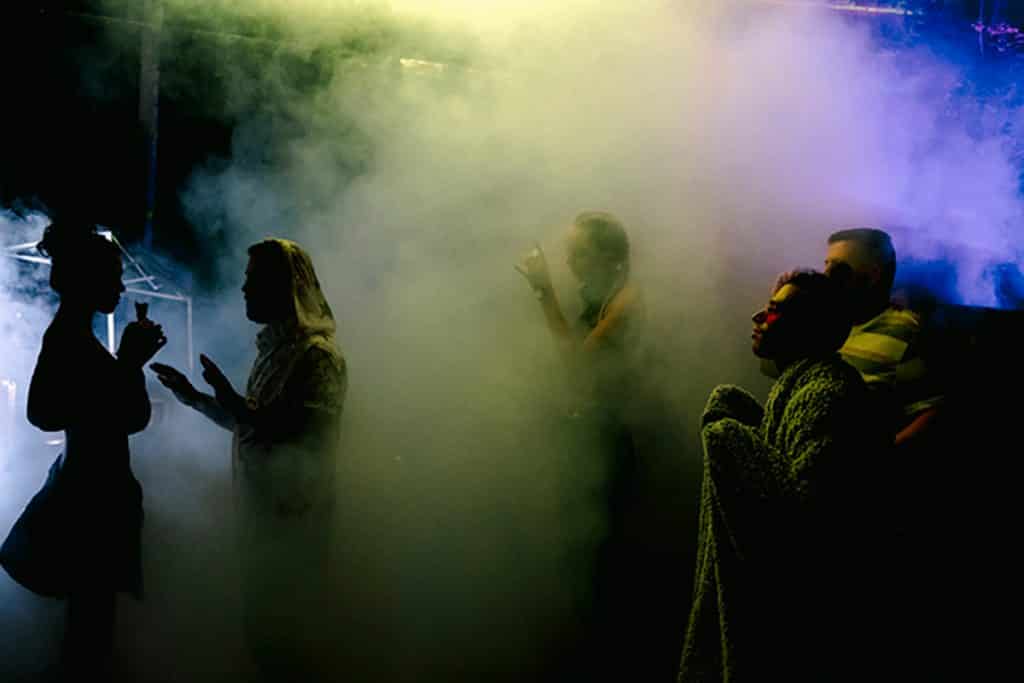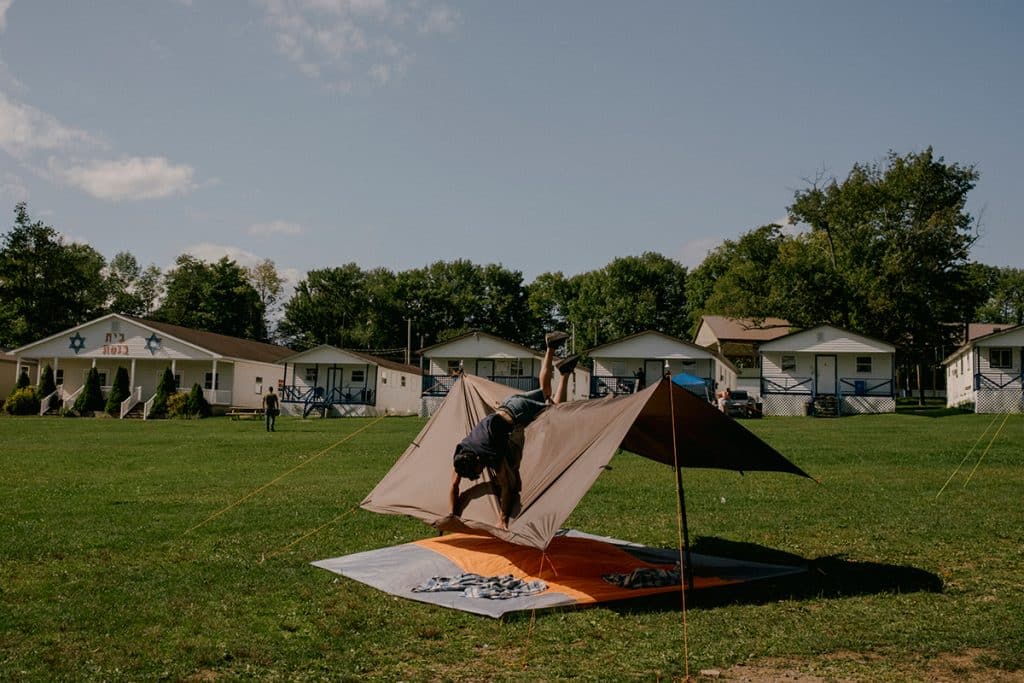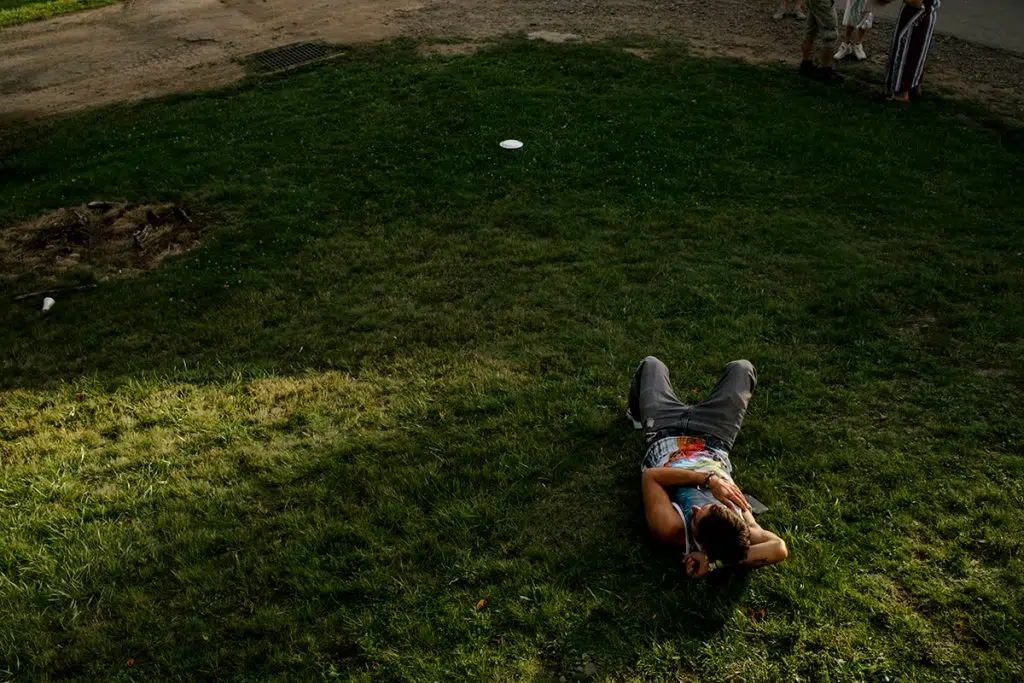“Who has medicine?”
The request wafts over the raucous of a Shabbos dinner table, scattered with plastic plates of half-eaten gefilte fish, hummus, and ripped up loaves of challah. A guy with long hair, a long beard, and a knit yarmulke that fits like a beanie says he has ketamine, but the medicine seeker is looking for shrooms. It takes only a second for someone else to make an offer.
It’s midnight on a Friday in mid-July, but the party is only just getting started and will last for the next 36 hours, kicking off with musical davening (prayer) and a cappella niggunim (traditional Jewish melodies), before eventually transitioning to electronic trance music. Outside, the sky twinkles with stars—easier to see up here in the Catskills than back home in Brooklyn.
Over the past seven summers—since I initially met some of the folks who brought me into this scene, first as a journalist and then as a participant—these weekend camping festivals in rural New York, which take place over the Jewish Sabbath (Shabbat in Hebrew or Shabbos in Yiddish) at private properties or vacant summer camps, have grown more popular. And psychedelics have played no small role in fueling them, as they have taken on a countercultural feel.

“It’s like the Sixties, but for the Jews,” my friend Heshy projects into my ear. Say what? I can hardly hear him over the garage band belching out traditional Shabbos songs. “You know,” he reiterates, “it’s like the Summer of Love, but by the Hasidim.”
While Hasidic Judaism, a form of ultra-Orthodoxy that originated in 18th-century Eastern Europe and now has about 250,000 followers worldwide, entails strict adherence to a set lifestyle (dressing a certain way, following religious law, and for most people, starting a family by your early 20s), a growing plurality of kids are questioning that path—and they’re using psychedelics to do it. From ketamine and MDMA, to LSD and magic mushrooms, and even ayahuasca in ceremonial settings, today’s young seekers in their 20s and 30s, many of whom descend from Holocaust survivors and hail from the greater New York area and Brooklyn neighborhoods of Williamsburg, Borough Park, and Crown Heights (as well as places like Israel and Los Angeles), aren’t necessarily shunning religion, but rather searching for a more fitting relationship to spirituality, and a sense of healing—whether from intergenerational trauma due to centuries of anti-Semitic persecution, or ongoing trauma from the shadowside of religious life.
But questioning or deviating from the standard way of life in “the system” doesn’t necessarily mean going OTD or “off the derech [path]” in the sense of completely cutting ties with the community (although for some, especially of an older generation, it has meant just that). Instead, many young Jews, especially from Hasidic backgrounds, are redefining what it means to embrace heimish (pronounced “HIME-ish” or “HAIM-ish”) culture—while perhaps shunning some Orthodox expectations. Yiddish for “homey,” the term heimish connotes a community-driven way of life, replete with the cultural hallmarks (food, language, rituals) of black-hat Jewry.
How to Grow Shrooms Bundle
Take Both of Our Courses and Save $90!
“A sense of heimishness entails looking out for one’s fellow Jew”—a “with us or against us” mentality leftover from European pogroms and the Holocaust that explains the insularity of the Hasidic community, says Heshy, who himself has shucked his peyos (religious sidelocks), yet still lives in the modernday shtetl (Jewish vilage) of South Williamsburg. But in the psychedelic corner of the Yiddish-fluent world, the heimish flair also extends to the freedom-loving fringe, holy rebels, and those who’ve ventured outward and inward to explore themselves before passing on old patterns and traumas to the next generation. “You’re either on the straight and narrow, or you’re here,” as one person put it, wrapping tefillin (prayer accessory) during a psytrance festival at an empty summer camp, with catered kosher food, attended by more than 100 people.
Read: The Psychonaut’s Guide to Kabbalah and Spiritual Journeying

“In a sense, they’re creating their own subculture because they can’t fully integrate, they don’t really have an education the way we had an education,” says Dartmouth Jewish studies professor Shaul Magid, referring to the difference between traditional schooling in the US and the yeshiva school system, where religious studies are front and center and secular subjects on the backburner. “They grew up in what we would call a ‘radical’ lifestyle—it’s radically focused on spirituality, on dvekus [closeness to God], on feeling and emotion, so in a way moving from a world where there’s value in a sense of experience into hallucinogens is not a big leap.” What’s more, he adds, Hasidim don’t grow up with the same cultural tropes and stigma surrounding psychedelics that secular people do.
Take Isaac Schwartz, 31, who first tripped on psychedelics when he was 22. Raised in Borough Park, Brooklyn, with Yiddish as a first language, he describes his younger self as “very frum [pious].” He attended yeshiva for 14 hours a day, studied Torah, and followed all the rules of being an observant Jew. But when he entered adulthood, he began to question Hasidic rituals; he wanted to know what gave them meaning.
He contemplated going OTD, and began to frequent underground parties in the City or psytrance festivals upstate. But around eight years ago, one summer changed everything for him. Schwartz went camping with an organization that helps Orthodox Jews transition into secular society. “Everything was bad about it,” he says. He had made no friends there and felt spiritually unmoored. He wasn’t necessarily looking to abandon the Orthodox world, but rather he hoped to commune with fellow skeptics and seekers within it.

He found his opportunity just a few weeks later, at a psytrance festival called Genesis, near the tiny village of Afton, in central New York State. “That was the beginning of everything,” recalls Schwartz, who tried LSD for the first time. “One weekend in 2013 was like Woodstock 1969.”
Genesis heralded a new era in the heimish festival scene, blending trance and tradition into campy weekend parties. Some take place over Shabbat (a weekly refrain from work starting at sunset on Friday evening and ending on Saturday evening) or other Jewish holidays like Shavuot or Rosh Hashana; others are more mainstream events, drawing Yiddish-speaking conclaves and secular ravers alike.
Access to this world is difficult; by serendipity, I stumbled upon this heimish fringe eight years ago in grad school for journalism, and have since specialized in reporting on the overlap between Judaism and the psychedelic experience. The interest is somewhat personal. My own parents were hippies active in the Ram Dass community of disillusioned post-Holocaust American Jews who sought spiritual connection in India or through psychedelics and cannabis. And through the lens of my own religious practice, as well as my friendships within the “HinJew” (Jews who practice Hinduism) and heimish spheres, I have found overlaps between these worlds.

I’ve seen partygoers blend rituals like wearing tefillin while dancing to techno, or preserving pounds of gefilte fish inside beer kegs. I observed a guy wearing a shtreimel and bekishe (the traditional round furry hat and black coat worn on Shabbat and special occasions) dealing tabs of acid out of a siddur (prayer book).
On one Shabbos morning during a private festival in the Catskills, someone unraveled a Torah scroll underneath a camping tarp, while psytrance music blasted from a parked car in muddy grass nearby—an obvious violation for those who keep Shabbat (which entails abstention from electronics). One guy in full Hasidic garb even moved to the beat, but in the traditional back-and-forth sway, called shuckling, that accompanies standing prayer. Beyond embracing this new spiritual path, today’s young seekers are finding that the “medicines” have helped them heal from residual psychological wounds, too.
“In a society or culture where ‘never forget’ becomes a very important mandate, the negative, as well as positive effects of a traumatic event can linger,” says Rachel Yehuda, a psychiatry professor at the Icahn School of Medicine at Mount Sinai and director of the Center for Psychedelic Psychotherapy and Trauma Research. “We want to have a more nuanced and refined understanding of the differences between why people seek out different kinds of drug experiences,” which will highlight specific needs, she says. But the public also needs to learn about psychedelics in “the most responsible and healing manner,” she adds, noting that she doesn’t advocate for the use of psychedelics in party settings because they are illegal.
Much of Yehuda’s research pertains to the descendents of Holocaust survivors; and a majority of American Hasidim fall into this demographic. In addition to other forms of ongoing trauma in religious communities (such as in some cases, child sex abuse), many young people are choosing to self-medicate, or at the very least, are renegotiating their relationship to the mainstream religious community.
During the festival at the empty summer camp mentioned above, I met Yitzi, perched on a hill with a crew of boys overlooking a lake, as bikini-clad women, queer folk with poi (a performance prop), and men in tzitzis (religious garment) passed us by. At 23 years old, he still lives with his parents and with his peyos appears religious; he had recently tried a full dose of magic mushrooms for the first time. “I like to escape myself, go for a chill, [and] get to the real me,” he says. That core self, he explains, is at peace, spiritually grounded, strong, and able to persevere through life’s challenges. “When you do drugs, it boils down to one thing: yourself and God, and He’s got your back,” Yitzi tells me. “I try to be afraid of no one besides God, [but] I don’t know if the way I was raised is the way I want my children to be raised.”
Read: Jewish and Transgender

For kids who first get exposed to psychedelics in the party scene, it can be a “gateway medicine,” according to Rabbi Harry Rozenberg, an educator on the topic of psychoactive plants in Jewish text and co-founder of the Theological Research Institute. “They may not realize they were getting into something deeper, and all of a sudden they’re thinking about life and childhood trauma and coming to terms with things.”
And for parents, that’s not the worst thing that could happen, Rozenberg continues. “Would you rather your kid be OTD, lost from the community, having shunned HaShem [God], changed their name, and cast off the religion? Or perhaps a better outcome would be for your kid to have a neurological reset and return to some form of loving God and raise their kids in a heimish home—that’s a win.”
Moreover, with the opiate crisis threatening the Heimish community as in mainstream America, psychedelics offer a potentially healing alternative without necessarily promoting continued drug use. At the age of 24, Shulamis Singer, who had a young child and an opiate use disorder, did an ayahuasca ceremony “once and only once” with an Orthodox-raised medicine provider, then left her toxic marriage, and turned her life around. “We bury kids every single week,” says Rozenberg. “We have to start being efficient with how we view these things and look outside the box of what’s being presented as solutions.”

And as policies change, psychedelics are becoming less and less out of the box—at least as far as what’s legal goes. MDMA and synthetic psilocybin have been fast tracked by the FDA to be used in psychedelic-assisted psychotherapy for trauma and depression, respectively, early this decade, while ketamine clinics using the dissociative anesthetic off-label to treat conditions like depression or trauma are popping up around the country. And for ayahuasca, LSD, DMT, and even novel psychedelic compounds, ongoing research is showing promise in their ability to treat a variety of mental health conditions. Meanwhile, a robust decriminalization movement is sweeping North America, aiming to provide safe and equitable access to these substances—outside the clinical or pharmaceutical paradigm. And in the heimish community, there are some organizations, such as a nonprofit called Darkhei Rephua (Paths of Healing), that are beginning to sprout up, specifically to promote policy change and to reduce stigma around entheogens in the religious world.
How to Grow Shrooms Bundle
Take Both of Our Courses and Save $90!
It’s true that some who dabble in psychedelics explore other drug realms, as well, and not always in healthy ways. I recall an apartment complex in Bushwick back in 2015, where many from this Yiddish-speaking psychedelic fringe lived and partied. The place felt like a dorm for wayward seekers zonked out on ketamine or whatever they could get their hands on, watching videos of Burning Man or Goa Gil psytrance festivals from beanbags on a grimy floor. The most telling part, though, was a yellowed wall where they scrawled out every drug they could think of in a vertical list, marking the ones they’d done (including compounds like 2Ci or Roxies, in addition to “basics” like LSD).
While the concern among elders, parents, and administrators regarding drug use among youth is well documented, “most people raised frum [religious] from birth have not been exposed to psychedelics and I don’t think people understand it,” says psychologist-psychoanalyst Dr. Alison Feit, a.k.a.Freudina, who consults with rabbis, community leaders, and young adults from all parts of ultra-Orthodox societies. “People don’t think of drugs as substances kids use to self-medicate when they’re depressed or anxious; people are not talking about a spiritual void in kids as seekers and therefore dropping acid.”
Heimish party culture might not be regulating drug use in the way that hospitals and clinics are, but the end goal, they say, is the same: To heal. And part of the healing, Schwartz argues, is religious.
Read: Rick Strassman on DMT and the Mystical State

At the point when Shwartz began to dabble in psychedelics, he had already been doubting the existence of God, he says. But LSD and magic mushrooms gave him a new perspective. “It went from ‘This has to be something requiring faith’ to ‘I saw it and there’s no question.’” It affirmed his belief in a renewed understanding of “God as spirit”—not “as the almighty with rules about things that he doesn’t want you to do,” but rather, he said, that “God is in everything and there’s God within all of us.” This new outlook, Schwartz says, felt more aligned with the origins of Hasidic Judaism. “What the Baal Shem Tov meant to teach,” he said, referring to the rabbi who founded the Hasidic movement, “was for people to understand what I saw, but without the technology of LSD.”
The Baal Shem Tov, also known as Rabbi Israel Ben Eliezer, is cherished as the father of the Hasidic movement, which developed as a rebellion to a more rigid, academic form of Judaism that was popular at the time in Europe. An herbalist from the woods of Ukraine, he was known to smoke from an enchanted pipe. He introduced a more ecstatic approach and encouraged working-class people to directly access the divine, a right usually reserved for the rabbinic upper class. Dancing, clapping, singing, meditation, alcohol, maybe even other entheogens (any substance, from alcohol to magic mushrooms, that can help elicit a spiritual experience) became tools to achieve transcendence.
Over time, however, the more mystical elements of Judaism were drowned out amid efforts to simply survive during a time of rampant anti-Semitism. “Especially after the Holocaust,” Schwartz explains, “the previous generations made the demand, ‘Oh, Hitler wanted to eradicate us, so we’re going to make sure to preserve everything.’” This led to a culture that some perceived as valuing form—dress, language, tradition—over spiritual substance. In a way, current drug experimentation among young Hasidic Jews could be interpreted as an attempt to regain the spirituality that was lost over years of just trying to control and survive the trauma.

Most Orthodox Jews are unaware of psychedelics in young heimish culture, so are not yet weighing in on the practice. “Mainstream rabbis will not publicly talk about problems that are not yet widespread enough,” says Meyer Labin, a Yiddish writer and journalist from Brooklyn. “They won’t come out and make it an issue when they don’t feel it’s an issue if it’s not impacting on a mass scale. There’s an unspoken understanding that if it works for certain people, that’s fine, but we don’t want to institutionalize it.”
Still, the movement has momentum, Labin says, and whether the religious world at large will support it remains in question: “I feel that the fascination about psychedelics is reaching the mainstream because there’s a spiritual agony in all communities—even in the heart of the Hasidic community.”
For Schwartz, pushback from friends and family came not because he was experimenting with psychedelics but because he became less religiously observant. “It’s unfortunate that a lot of teenagers end up losing touch with the community and go off the deep end, which I feel could have been avoided if we had spaces where we integrate our spirituality and traditions,” Labin says. “It’s an integration problem,” he emphasizes. “Not a drug problem.”

The irony, of course, is that psychoactive substances have been central to Jewish tradition since Biblical times: A recent archaeological dig uncovered cannabis residue in an ancient Israelite shrine, while scholars point to a tradition of the high priest of Jerusalem “hotboxing” himself on Yom Kippur, the holy day of atonement, in a small room of the Temple, filled with incense made from not just kaneh-bosm (cannabis), but also acacia wood (which contains DMT).
And in contemporary Jewish practice, some are integrating psychedelics into prayer and ritual—from singing niggunim as medicine music during plant medicine ceremonies, to more rogue expressions of spiritual connection. At the vacant summer camp festival, a Williamsburg native running around in tzitzit and a tank top describes how one morning, he ran into the forest and screamed out the Sh’ma (a staple prayer). To cry out to God, into the depths, is an aspect of a practice known as hitbodedut—meditation in seclusion, out in nature, and speaking from the heart, directly to God. But the Sh’ma screamer says you can talk to God anywhere, even on the dancefloor, where a couple bumps of ketamine enable him to communicate with the divine. Dancing, too, is another mandate, specifically from Rebbe (Rabbi) Nachman of Breslov. The 18th century rabbi from Bratslav, Ukraine, encouraged his Hasidim to dance, since moving the body is an avenue to joy—and for Nachman, being happy was the greatest mitzvah (commandment).
Indeed, Judaism and hasidut—that is, the spiritual framework of the religion itself, as well as the mystical philosophy and rituals accompanying it—offers a container through which to have a psychedelic experience and integrate it into mundane life. The Torah, Kabbalah, and other Jewish texts abound with stories and ideas that challenge our rational, ordinary thought process into expanded consciousness. And meanwhile, embodied practices like dance, meditation, prayer, sex, even wrapping tefillin—which all may fall under the jurisdiction of religious practice—allow the parasympathetic elements of spiritual connection to sink in on a somatic level, into the body. Indeed, the practice of Judaism, replete with its own calendar and opportunity to claim sacred, transcendent time—such as Shabbat, a 25-hour mindfulness practice of “being here now”—itself can engender an altered state, even without substances.
Read: How Psychedelics are Reigniting Judaism

For myself personally, however, and for others in the community, I’ve found that integrating a psychedelic into Jewish practice, like MDMA or ayahuasca on Shabbat, or mushrooms on Rosh Hashanah, has helped give new depth and connection, transcendence and ecstasy, to the religious practice in a way I could consequently harness, without the drugs for months, or years to come. Only here and there do I need to dip back in to remember.
There’s a growing precedent, too, for incorporating transcendent experiences into mainstream Hasidut. Take, for instance, Uman, Ukraine, where Rebbe Nachman died in 1810, and which has become a destination for thousands of Hasidim who travel there every Jewish New Year to pray at Nachman’s gravesite. Uman Rosh Hashanah, dubbed by VICE as the Hasidic Burning Man, has grown exponentially in recent years, lending greater legitimacy in the mainstream heimish world to the community’s blooming counterculture.
In the heimish psychedelic party scene, says Heshy, nobody shows up alone. We’re sitting by the porch on a lazy Shabbos afternoon with floating cloud coverage over rolling hills dotted with camp cabins, surrounding forest, and a lake. People wander past us, in and out of the homebase cabin, to grab water bottles, take a bite of homemade cholent (traditional stew), re-apply glitter, or crash for a nap on a bunk bed mattress. For most people, he says, it’s not their first time around, and if it is, they’re with a group and “know they have help.” It’s like they’re getting “house trained” for the festival scene, taking care of one other as a “natural instinct,” Heshy says. “It’s engraved in us, like from World War II” as part of what he suggests is a heimish mentality that’s here to stay.

But psychedelics, themselves have helped many forge a more flexible approach to heimish culture, religion, and life. “They bring kugel to camping trips and they’re not keeping Shabbos—I call that evolution,” says Schwartz, ruminating on the future of the community and predicting that soon, there could be frum-optional schools for Yiddish speakers.
“They’re creating an alternative Judaism, as opposed to the OTD world of 25 years ago, which is basically where people left the world completely,” says Magid. “They don’t want to be frum, but there’s something about it that they miss, some sense of belonging,” he says. “And in a sense, yeah, tripping in the woods, staying up late at night, singing niggunim—there’s a spiritual flavor to that world, and they’re saying, ‘Why do we have to give up on it?’”
Schwartz agrees with that sentiment. “People look at religion and make it work for them, not the other way around,” he says. “They realize religion is meant to make your life happier.”
This article was originally published in DoubleBlind Magazine Issue 7.

DoubleBlind is a trusted resource for news, evidence-based education, and reporting on psychedelics. We work with leading medical professionals, scientific researchers, journalists, mycologists, indigenous stewards, and cultural pioneers. Read about our editorial policy and fact-checking process here.

DoubleBlind Magazine does not encourage or condone any illegal activities, including but not limited to the use of illegal substances. We do not provide mental health, clinical, or medical services. We are not a substitute for medical, psychological, or psychiatric diagnosis, treatment, or advice. If you are in a crisis or if you or any other person may be in danger or experiencing a mental health emergency, immediately call 911 or your local emergency resources. If you are considering suicide, please call 988 to connect with the National Suicide Prevention Lifeline.



